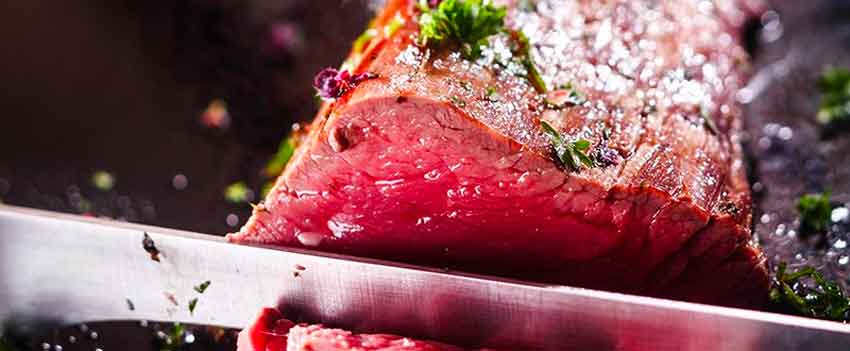Buying meat and poultry, whether at your farmers market or Costco, can be confusing. Labels from Organic to Grass Fed to USDA Prime tell us part of the story, but what do they tell us about the welfare of the animals, the feed they’ve been given and how they have impacted or benefitted their environment? We gathered a number of farmers, butchers, distributors and farmers market managers at the school this week and asked them to break down a number of terms to help us in make more informed purchasing decisions. Scroll down further for a list of farmers and where to buy their locally, sustainably grown and harvested meats.
HOW MEAT GETS FROM THE FARM TO YOUR PLATE
Producers are the farmers who raise animals. There are small, medium, large, extra large and gargantuan operations that raise everything from chicken to bison. The very large majority of farms raise livestock solely for meat, but a growing (yet still tiny number by comparison) of farms are practicing integrative farming as part of a larger system of crop and animal rotation.
Slaughtering and Processing. Once the cows have been raised to the point where they are ready for slaughter they are transported to a processing facility. These facilities range, like the producers, from large feedlots where even grass-fed animals are fattened with grain to smaller operations working with co-operatives that are able to process a small number of animals a month. Large and small farmers alike have to pay for the shipping from the farm to the slaughterhouse (after finding one that will treat their animals as well as they have) and back to the farm or to a distribution warehouse before getting driven to your local farmers market, butcher shop or sold to a grocery store.
The Butcher. Chefs have long extolled the virtues of the butcher’s craft. The art of breaking down an animal into pieces suited for best results in the kitchen is not lost on anyone who has tried to successfully cook a steak. Thinner cuts of steak are often over-cooked, perfect marbling butchered (no pun intended) by less knowledgeable knife wielders and careful consideration of preserving organs and less-often used (albeit delicious) parts of the animal all contribute to waste. Purchasing meat from a local butcher puts you at an advantage; butcher shops often know the farmers and demand a better product. Cows who were well taken care of taste better and are better for you, plain and simple, and since the butcher wants to see you again after you’ve cooked with her meats, it’s in their best interest to match their craft with that of the farmer.
Fresh vs. Frozen. Shoppers at farmers markets are often surprised at the number of meats that are sold frozen. For small farms, selling fresh meat can be cost and infrastructure-prohibitive. A farmer who moves loads of cattle a week can afford to turn fresh meat over, but smaller farmers selling directly to consumers need more time to make sure all the cuts of meat move- from prime ribs to organ meats before they expire. Don’t be afraid of cooking with frozen meat- we’d take a local grass-fed pound of frozen ground beef over fresh conventional any day of the week.
Pricing. Our insatiable hunger for inexpensive meat, coupled grain subsidies, have created a industry that’s driven the price of beef down so far that a great price chasm exists between the meat you pick up at a conventional grocery store and the local, grass-fed cuts you are purchasing through CSAs, farm boxes, farmers markets and specialty grocers. The biggest cost differential for small, independent and sustainable farms is volume. Transporting small numbers of animals to facilities willing to process these lower orders costs more for a little operation than a big one, and these costs can often fluctuate wildly. Slaughter facilities are few and far between, (the USDA has stringent requirements for these facilities, making them incredibly costly to open and operate), but more great quality meats you purchase from these entrepreneurs the more purchasing power they’ll have to drive costs down on their end.
READING MEAT LABELS
Here’s a brief overview of the terminology you’ll see from your favorite vendors and packaging.
Grass Fed: Grass fed beef is better for you, bar none, than grain fed. Cows aren’t designed to eat grain, which can often cause complications in their digestive system, leading to over-medication and a host of other problems. Cows who graze grassy plains produce meat with more than twice the heart-healthy Omega-3 fatty acids than grain fed cows (know why fish is so good for you? They’re eating grass-like seaweed and kelp). Grass fed cows need several months to a year longer to fatten up than grain fed ones, which is why some are labeled grass-fed-grain-finished.
The grass-fed term is not regulated by the USDA. There’s a lot of loose interpretation here, but talk to the vendors at your market. You may find that they’ve had to switch to grain due to the drought or let the cows fatten up in the feedlot or moved some of their animals to greener (read: northern) pastures. There are many producers here in central and Southern California producing entirely grass-fed beef, almost always on pesticide and herbicide-free land.
Organic: Animals are fed Organic feed. The cows might be grazing on grass on a certified Organic piece of land, but they might also be factory-farmed and munching on certified Organic grains, contributing to a host of problems linked to factory farming, methane and waste issues. Ask questions, look up the company’s website and call to learn who they buy their meat from and what they feed their animals.
USDA: Prime, Choice and Select: These designations help to understand how much marbling is in the meat. Prime cuts are typically the most marbled and sold to restaurants, Choice cuts are from the loin and ribs and are more tender, followed by Select cuts for the leanest, least juicy parts. None of these terms have anything to do with the health and quality of the animals themselves; they are simply designed to assign levels of fat distribution based on their cut and inspection.
Marbling: Your cuts of meat have three areas of fat on them; the perimeter, between muscles and the small pockets of fats that occur throughout the meat. Marbling in meat refers to the small pockets (think of the pieces of butter speckled throughout your pie crusts) embedded in the meat itself. Good marbling on a steak contributes to great flavor, though grass fed beef’s meat has better taste superior aside from the fats.
5 GREAT FARMERS MARKETS SELLING SUSTAINABLE MEATS
We love shopping at these markets for all the hard work that their managers do, from visiting the farms to conducting customer surveys and doing their part to support farmers and their market shoppers.
Santa Monica Farmers Markets: The 5 markets run by the City of Santa Monica offer a wide range of selections, from produce growers who supplement with goats and chickens to fifth-generation ranchers specializing in beef or pork.
Torrance Farmer Market: Manager Joyce Chan has curated a great roster of farmers at our favorite South Bay Market.
Hollywood Farmers Market: This large market services a big footprint- it’s easily accessible from Hollywood to the Valley on Sunday morning.
La Cienega Farmers Market: Manager Cynthia also runs a smaller market at Kaiser and has made inroads in creating access to quality produce and meats for every price point.
Mar Vista Farmers Market: This market has a great rotation of producers and has woven their products into the prepared foods section- Diana’s market wins for collaboration and community building.
OUR 5 FAVORITE SOCAL BUTCHER SHOPS
We picked these fine artisans because of their commitment to purchasing locally and sustainably grown beef, pork and fowl.
Gwen: Alex Jermasek runs the butcher shop adjacent to Gwen. He is known for outstanding charcuterie ranging from duck prosciutto to goose rillettes (you can catch him teaching our butchering classes).
Belcampo: This company is unique because they raise all their own animals on their own land. We love seeing the seasonality of products from duck to rabbit at their Santa Monica and downtown L.A. locations.
A Cut Above: The newest westside butcher shop has a great selection and is a reliable source of lard and bones (great for broth) when you need it.
Le French Butcher: This mid-city shop is run by a husband and wife team from France. Jean-Claude honed his craft for nearly 50 years before opening this spot.
Electric City Butchers (for all of you in Orange County): These guys hark back to the old school tradition of cutting to order. You won’t find a traditional display here, but an opportunity to let the butchers know what you’re cooking and get your cuts fabricated while you wait.
THE FARMERS!
All of this information was compiled thanks to a strong showing from the part of the farmers from ranches near and far. Thank you for all that you do to produce a product we can get behind!
5 Bar Beef: Frank Fitzpatrick and his family produce exclusively grass-fed beef in Indio and sells to farmers markets and online.
Novy Ranches: This stunning farm sits in view of Mt. Shasta and produces grass fed beef for sale at farmers markets and select independent grocers.
Autonomy Farms: We love that this company practices integrative farming and supplies various farmers markets with a range of produce, eggs and meat.
Diamond Mountain Ranch: You can pre-order a variety of meats, from Bison to grass fed beef from this family operation.
SZ Cattle Ranch: Located in the Cuyama Valley where apple picking is popular, this ranch sells beef, eggs and turkeys.
Jimenez Family Farm: Marci and her husband run this farm in the Santa Ynez Valley and sell goat, chicken and a variety of produce (including our favorite fresh garbanzo beans).
Linda Vista Ranch and Weiser Farms: Alex and John’s efforts in raising heritage pigs are as important as their work in the local grain movement. Their farm in Tehachapi is a model in many ways (stay tuned for a Pork buying guide)!

